Higher Education Market Size 2025-2029
The higher education market size is forecast to increase by USD 117.9 billion, at a CAGR of 18.9% between 2024 and 2029.
- The market is experiencing significant shifts driven by advances in educational content delivery methods and the increasing prioritization of AI technology-integrated course offerings. This transformation is fueled by the growing expectation for flexible and accessible learning solutions, as well as the need to accommodate the rising cost of higher education. Institutions are increasingly adopting digital platforms and tools to enhance teaching and learning experiences, enabling students to access course materials and engage with instructors from anywhere, at any time. However, this transition poses challenges, such as ensuring data security and privacy, addressing the digital divide, and maintaining academic rigor in a technology-driven environment.
- The market continues to evolve, with dynamic market activities unfolding across various sectors. Student support services, such as continuing education and financial aid, remain crucial in ensuring student success. Curriculum development and research collaboration are key areas of focus for higher education institutions, driving the need for instructor training and campus infrastructure improvements. Digital literacy and educational technology are increasingly integrated into degree programs, from bachelor's degrees to doctoral degrees, with online courses and blended learning becoming more prevalent. Digital archives and online libraries provide essential resources for students and faculty, while research funding and tuition fees shape the financial landscape.
- Cybersecurity incidents in education rose by 44% year-over-year in 2023, making data security and privacy critical concerns. Additionally, an estimated 34% of students in low-income or rural areas still lack reliable internet access, highlighting the persistent digital divide. To capitalize on these opportunities and navigate these challenges effectively, higher education institutions must remain agile and innovative, continuously adapting to the evolving needs of students and the market.
Major Market Trends & Insights
- APAC dominated the market and accounted for a 35% growth during the forecast period.
- The market is expected to grow significantly in North America as well over the forecast period.
- By the Learning Method, the Online sub-segment was valued at USD 33.59 billion in 2023
- By the End-user, the Private colleges sub-segment accounted for the largest market revenue share in 2023
Market Size & Forecast
- Market Opportunities: USD 294.62 billion
- Future Opportunities: USD 117.9 billion
- CAGR : 18.9%
- APAC: Largest market in 2023
What will be the Size of the Higher Education Market during the forecast period?
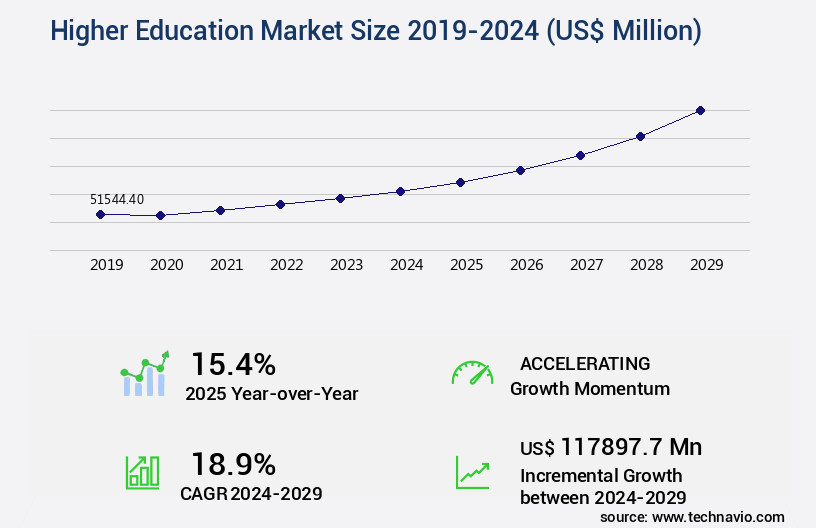
Understand digital transformation trends in Higher Education Request Free Sample
- The higher education market is experiencing rapid transformation, driven by the adoption of digital learning platforms, smart classroom technologies, and cloud-based education management systems. Institutions are increasingly implementing data analytics dashboards and AI-driven learning management systems to personalize student experiences and improve operational efficiency. The growing integration of automation features, predictive analytics, and compliance management tools aligns closely with the EdTech Solutions Market and smart campus market, ensuring streamlined academic processes and resource optimization.
- Modern campuses are leveraging building automation and IoT in Education Market to enhance sustainability, energy efficiency, and student safety. Furthermore, virtual learning environments, VR-based simulations, and adaptive assessment tools are reshaping how institutions deliver education, enabling flexibility and scalability. Internal linking opportunities exist with markets like learning management systems, Cloud-Based Property Solutions Market, and Facility Management Software Market, which share synergies in infrastructure optimization and digital administration.
- Recent analysis suggests that over 72% of higher education institutions plan to expand technology budgets for e-learning platforms by 2029, reflecting a strong focus on automation, data-driven decision-making, and student-centric solutions for competitive advantage.
- Retention rates and graduation rates are essential metrics, with career services and alumni relations playing a crucial role in student engagement and post-graduation success. As of 2023, the average first-year retention rate in U.S. colleges was around 76%, while the six-year graduation rate stood at approximately 64%, highlighting the ongoing need for stronger student engagement and support systems. Personalized learning, gamified learning, and adaptive learning are innovative approaches to teaching and learning, while faculty development and e-learning platforms support the ongoing professional development of educators. K-12 education and international students contribute to the diversity of the higher education landscape, with joint degree programs, associate degrees, and certificate programs offering flexible educational paths. Intellectual property, learning analytics, and faculty recruitment are critical areas of focus for institutions seeking to stay competitive in the ever-changing educational landscape. Learning analytics adoption has grown by 35% over the past three years, enabling institutions to make data-driven decisions about curriculum design, student performance, and resource allocation.In this dynamic market, higher education institutions must continually adapt to meet the evolving needs of students and the workforce. From curriculum development to faculty training, digital resources to student support services, the ongoing evolution of the market is shaping the future of education.
How is this Higher Education Industry segmented?
The higher education industry research report provides comprehensive data (region-wise segment analysis), with forecasts and estimates in "USD million" for the period 2025-2029, as well as historical data from 2019-2023 for the following segments.
- Learning Method
- End-user
- Private colleges
- State universities
- Community colleges
- Geography
- North America
- Europe
- APAC
- South America
- Rest of World (ROW)
By Learning Method Insights
The online segment is estimated to witness significant growth during the forecast period.
The market is experiencing significant changes as institutions adapt to evolving student needs and technological advancements. Online courses are becoming more prevalent, with platforms transitioning from static content delivery to interactive, immersive environments. Digital tools, such as real-time collaboration features, virtual classroom experiences, and adaptive learning algorithms, are enhancing engagement and catering to the demands of diverse learner demographics, including working professionals and non-traditional students. Hybrid models, which blend online and in-person instruction, are gaining popularity as institutions recognize the complementary strengths of both modalities. Curriculum development is also undergoing transformation, with personalized learning and gamified approaches gaining traction.
Research collaboration and study abroad programs continue to be essential components of higher education, while educational technology and faculty development are key areas of investment. Financial aid and student loans remain critical to accessibility, as nearly 86% of U.S. undergraduates receive some form of financial assistance, underscoring the continued need for affordability solutions.Intellectual property and learning analytics are also key areas of focus, as institutions seek to protect their assets and optimize student outcomes. The market for k-12 education and continuing education is also growing, as individuals seek to acquire new skills and knowledge throughout their lives. Institutions are also investing in campus infrastructure, research funding, and library services to support their mission of providing quality education. Overall, the market is undergoing a period of significant transformation, driven by digital innovation and shifting pedagogical frameworks.
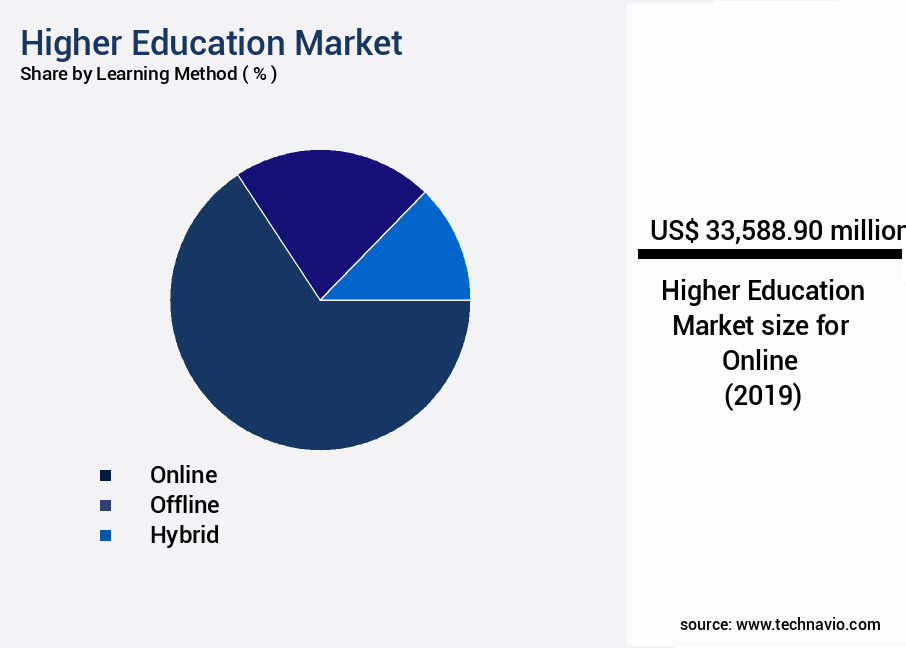
Request Free Sample
The Online segment was valued at USD 33.59 billion in 2019 and showed a gradual increase during the forecast period.
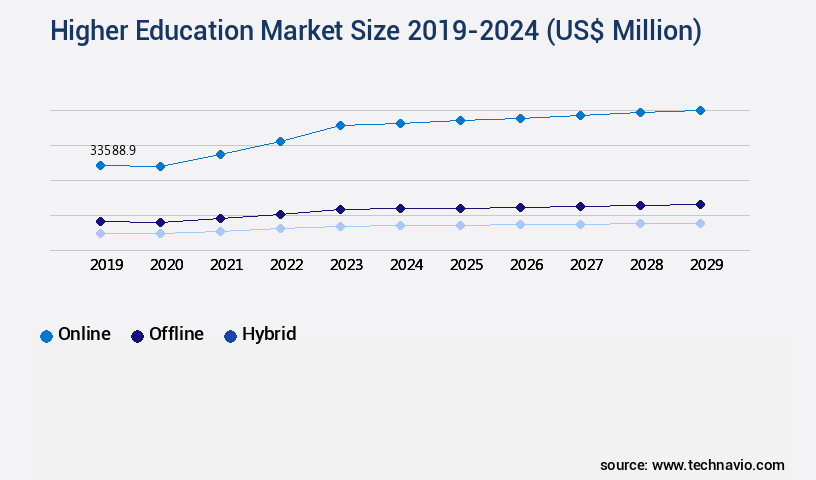
Request Free Sample
Regional Analysis
APAC is estimated to contribute 35% to the growth of the global market during the forecast period.Technavio's analysts have elaborately explained the regional trends and drivers that shape the market during the forecast period.
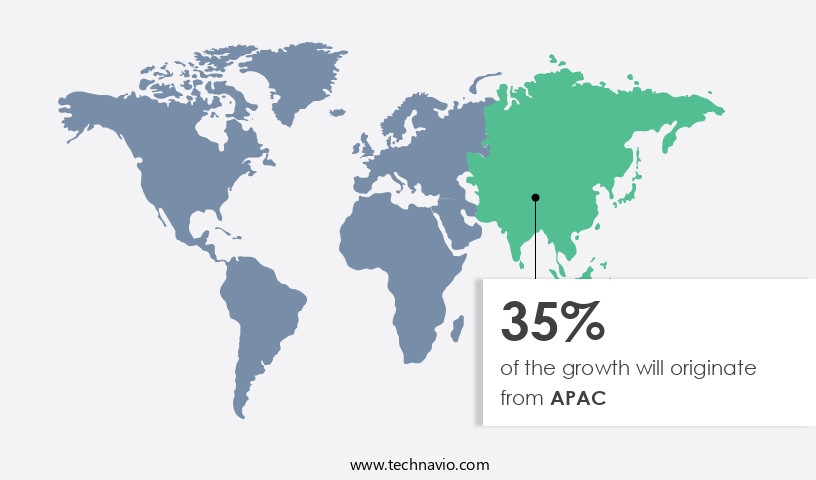
Request Free Sample
In the dynamic the market, North America leads due to the growing demand for superior education in developed economies. Institutions are investing in advanced technologies, such as educational technology and e-learning platforms, to enhance the learning experience and enable remote access to content. The US Department of Education's National Education Technology Plan (NETP) supports the implementation of adaptive learning in colleges. Additionally, the US government's Open Society University Network was launched in February 2020 to foster innovation and collaboration. Master's degrees, bachelor's degrees, and certificate programs are increasingly available online, while faculty development, curriculum development, and research collaboration are crucial for institutional growth.
Student support services, such as career services and financial aid, are essential for student success. Retention rates are a critical metric, and institutions are focusing on personalized learning, student engagement, and digital literacy to improve them. Research funding, intellectual property, and learning analytics are key components of research-intensive institutions. Dual degree programs, joint degree programs, and degree programs in various fields cater to diverse student needs. Campus infrastructure, library services, and alumni relations are also vital for student success and institutional reputation. Graduation rates, educational content creation, and professional development are essential for students' long-term success. International students and corporate training are growing sectors within the market, with the need for cross-cultural understanding and professional skills development.
Market Dynamics
Our researchers analyzed the data with 2024 as the base year, along with the key drivers, trends, and challenges. A holistic analysis of drivers will help companies refine their marketing strategies to gain a competitive advantage.
In the dynamic and evolving higher education landscape, institutions are continually seeking innovative ways to engage students and provide valuable, market-relevant learning experiences. Online and distance education programs, adaptive learning technologies, and personalized curriculum designs are transforming traditional classroom models. Student success and retention are top priorities, with institutions offering comprehensive support services, from academic advising to mental health resources. Sustainability initiatives, international collaborations, and experiential learning opportunities further enrich the higher education experience. As global competition intensifies, institutions are investing in research and development, fostering partnerships with industries, and focusing on workforce readiness to prepare students for successful careers in today's complex and interconnected world. Accessibility, affordability, and continuous improvement are key drivers in the market, ensuring that institutions remain responsive to the ever-changing needs of students and the workforce.
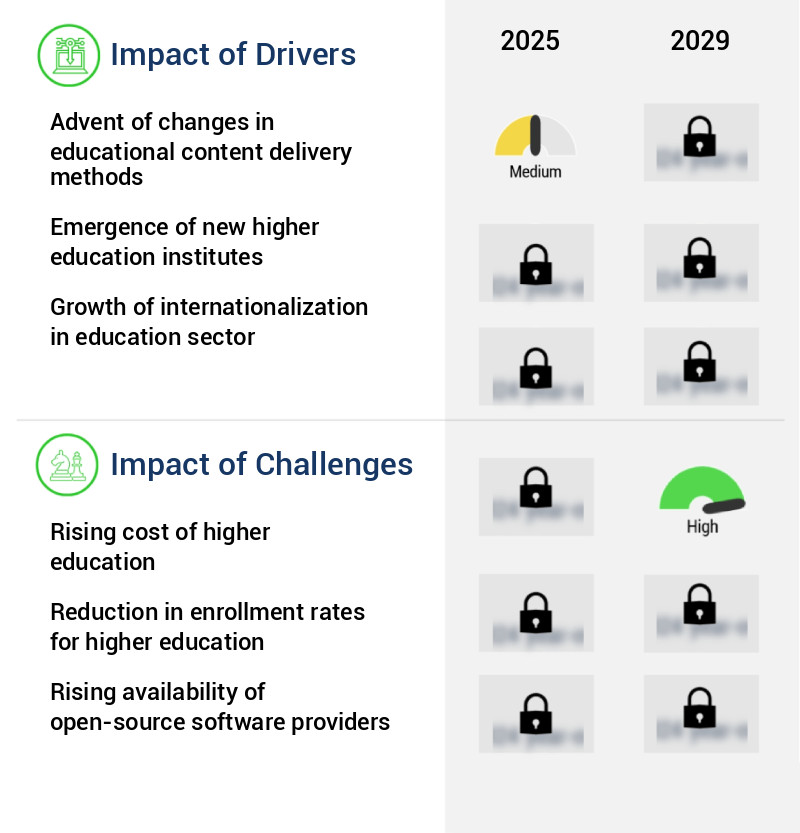
What are the key market drivers leading to the rise in the adoption of Higher Education Industry?
- The shift in educational content delivery methods, marked by the advent of advanced technologies and digital platforms, serves as the primary catalyst for market growth.
- Higher education institutions worldwide are embracing advanced technologies to deliver more engaging and effective learning experiences. This shift is driven by increased investment in hardware and software, leading to the adoption of innovative technologies such as educational gamification and hybrid or collaborative learning platforms. Gamification, which involves the use of game elements in non-game contexts, is gaining popularity in education due to its potential to enhance student engagement and make learning more student-centric. Flipped classrooms, a gamification-supported learning method, are increasingly being adopted by universities. In this approach, students watch videos and online lectures outside the classroom, allowing for more interactive and collaborative learning experiences during class time.
- Additionally, continuing education programs, master's degrees, and study abroad opportunities are being enhanced through educational technology, instructor training, and research collaboration. Financial aid, curriculum development, campus infrastructure, research funding, retention rates, career services, and personalized learning are also being optimized through technology to provide a more immersive and harmonious learning experience.
What are the market trends shaping the Higher Education Industry?
- The increasing prioritization of technology-driven education delivery is a notable market trend. This shift towards digital learning platforms is mandatory for professionals seeking to stay current in their respective fields.
- In the realm of higher education, institutions are increasingly embracing technology to enhance student success. Blended learning combining traditional instruction with online tools is now implemented by over 70% of U.S. colleges and universities, offering flexible and scalable models of instruction. Visual technologies, such as Virtual Reality (VR), are being utilized to deliver immersive and harmonious learning experiences. Gamification and simulations have become essential tools in this approach, providing students with interactive and engaging educational content. According to the US Department of Education, technology-based course delivery in post-secondary education fosters increased interactions among students and between students and instructors. This results in timely and targeted feedback on student performance, enabling students to tackle complex problems effectively.
- Furthermore, faculty development programs are being implemented to ensure educators are adequately prepared to integrate technology into their teaching methods. Degree programs, including bachelor's degrees, are increasingly offering online courses, allowing students to access education flexibly. Digital literacy is a crucial skill in this digital age, and higher education institutions are ensuring students are well-equipped with the necessary skills. As of 2023, approximately 40% of undergraduate students in the U.S. were enrolled in at least one online course. Digital archives are also being utilized to preserve and provide access to historical academic resources. Overall, technology is transforming higher education, focusing on student success and enhancing the learning experience.
What challenges does the Higher Education Industry face during its growth?
- The escalating costs of higher education pose a significant challenge to the industry's growth trajectory. The escalating tuition fees in higher education institutions have raised concerns among potential students, leading to a decrease in college enrollments. The cost of education in private colleges is notably higher than in government-funded institutions. Despite the increasing fees, the value and benefits of a college degree are not always proportionate. For instance, the average tuition fee in private, nonprofit, and four-year colleges has seen a substantial increase in recent years. This trend, coupled with the dwindling number of well-paying job opportunities, has made students hesitant to invest in higher education. To cater to this shift, educational institutions are exploring various alternatives, such as online libraries, online assessments, and e-learning platforms, to make education more accessible and affordable.
- Additionally, joint degree programs, associate degrees, certificate programs, adaptive learning, dual degree programs, and mobile learning are gaining popularity due to their flexibility and cost-effectiveness. Alumni relations and student loan facilities remain essential components of higher education, offering financial assistance and networking opportunities to students. These initiatives aim to strike a harmonious balance between the cost and value of higher education.
Exclusive Customer Landscape
The higher education market forecasting report includes the adoption lifecycle of the market, covering from the innovator's stage to the laggard's stage. It focuses on adoption rates in different regions based on penetration. Furthermore, the higher education market report also includes key purchase criteria and drivers of price sensitivity to help companies evaluate and develop their market growth analysis strategies.
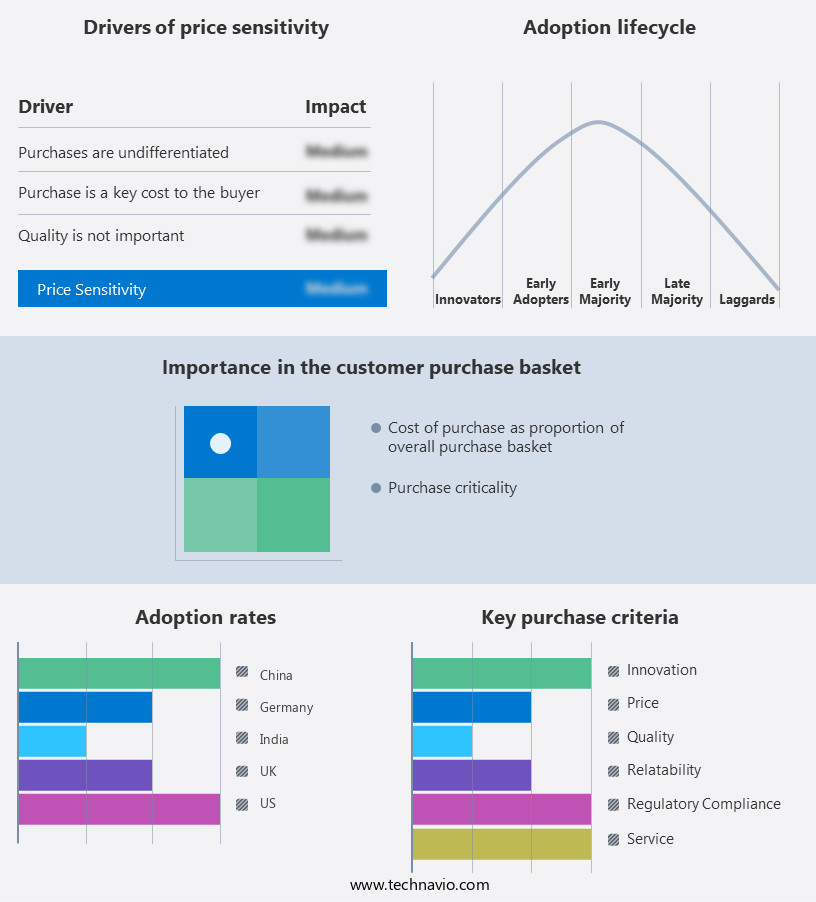
Customer Landscape
Key Companies & Market Insights
Companies are implementing various strategies, such as strategic alliances, higher education market forecast, partnerships, mergers and acquisitions, geographical expansion, and product/service launches, to enhance their presence in the industry.
Cisco Systems Inc. - This company specializes in advanced higher education solutions, encompassing digital learning and virtual campus environments, enhancing accessibility and flexibility for students worldwide.
The industry research and growth report includes detailed analyses of the competitive landscape of the market and information about key companies, including:
- Cisco Systems Inc.
- Class Technologies Inc.
- D2L Corp.
- Educomp Solutions Ltd.
- Ellucian Co.
- Fujitsu Ltd.
- Harvard University
- Instructure Holdings Inc.
- Jenzabar Inc.
- Massachusetts Institute of Technology
- Microsoft Corp.
- Oracle Corp.
- Pearson Plc
- Promethean World Ltd.
- SMART Technologies ULC
- Stanford University
- Unifyed
- University of Cambridge
- University of Oxford
- Xerox Holdings Corp.
Qualitative and quantitative analysis of companies has been conducted to help clients understand the wider business environment as well as the strengths and weaknesses of key industry players. Data is qualitatively analyzed to categorize companies as pure play, category-focused, industry-focused, and diversified; it is quantitatively analyzed to categorize companies as dominant, leading, strong, tentative, and weak.
Recent Development and News in Higher Education Market
- In January 2024, edX, a leading online learning platform, announced the launch of a new microdegree program in partnership with Microsoft and WGU (Western Governors University). This collaboration aimed to provide learners with industry-recognized credentials in data science, further expanding edX's offerings in technology-focused education (edX Press Release).
- In March 2024, Coursera, another prominent online education provider, secured a USD100 million Series E funding round, led by Blackstone Growth, to fuel product innovation and expand its global reach (Coursera Press Release).
- In May 2025, the European Commission approved the Erasmus+ program's new strategic framework, increasing its budget by 25% to €30 billion. This significant investment will support the mobility of students, staff, and institutions across Europe, promoting cultural exchange and skill development (European Commission Press Release).
- In the same month, the University of California, Berkeley, and Google Cloud announced a partnership to create a new AI research institute. The collaboration will focus on advancing artificial intelligence research and its applications in various fields, further strengthening the university's position as a leader in tech innovation (UC Berkeley News).
Research Analyst Overview
- In the dynamic the market, inquiry-based learning platform and project-based approaches are gaining traction, fostering a student-centered educational experience. Learning communities, both online and offline, facilitate social interaction and knowledge sharing among students. Cybersecurity in education is a pressing concern, with institutions investing in simulation software and digital publishing to enhance security measures. Sustainability in education is another trend, integrating problem-solving skills and accessibility in curriculum design. Collaborative learning, inclusive education, and technical training are essential components of lifelong learning, catering to diverse populations.
- Communication skills, critical thinking, and problem-solving abilities are increasingly valued in the workforce, necessitating the adoption of assessment tools and open access publishing. Adult education and vocational training programs emphasize skills development and community engagement, while special education and grading systems undergo transformation to accommodate individual learning needs. Overall, the higher education landscape is evolving, prioritizing student engagement, accessibility, and workforce relevance.
Dive into Technavio's robust research methodology, blending expert interviews, extensive data synthesis, and validated models for unparalleled Higher Education Market insights. See full methodology.
|
Market Scope
|
|
Report Coverage
|
Details
|
|
Page number
|
204
|
|
Base year
|
2024
|
|
Historic period
|
2019-2023 |
|
Forecast period
|
2025-2029
|
|
Growth momentum & CAGR
|
Accelerate at a CAGR of 18.9%
|
|
Market growth 2025-2029
|
USD 117897.7 million
|
|
Market structure
|
Fragmented
|
|
YoY growth 2024-2025(%)
|
15.4
|
|
Key countries
|
US, UK, Germany, Canada, China, Brazil, India, France, Saudi Arabia, and Japan
|
|
Competitive landscape
|
Leading Companies, Market Positioning of Companies, Competitive Strategies, and Industry Risks
|
Request Free Sample
What are the Key Data Covered in this Higher Education Market Research and Growth Report?
- CAGR of the Higher Education industry during the forecast period
- Detailed information on factors that will drive the growth and forecasting between 2025 and 2029
- Precise estimation of the size of the market and its contribution of the industry in focus to the parent market
- Accurate predictions about upcoming growth and trends and changes in consumer behaviour
- Growth of the market across North America, Europe, APAC, South America, and Middle East and Africa
- Thorough analysis of the market's competitive landscape and detailed information about companies
- Comprehensive analysis of factors that will challenge the higher education market growth of industry companies
We can help! Our analysts can customize this higher education market research report to meet your requirements.
Get in touch
1 Executive Summary
- 1.1 Market overview
- Executive Summary - Chart on Market Overview
- Executive Summary - Data Table on Market Overview
- Executive Summary - Chart on Global Market Characteristics
- Executive Summary - Chart on Market by Geography
- Executive Summary - Chart on Market Segmentation by Learning Method
- Executive Summary - Chart on Market Segmentation by End-user
- Executive Summary - Chart on Incremental Growth
- Executive Summary - Data Table on Incremental Growth
- Executive Summary - Chart on Company Market Positioning
2 Technavio Analysis
- 2.1 Analysis of price sensitivity, lifecycle, customer purchase basket, adoption rates, and purchase criteria
- Analysis of price sensitivity, lifecycle, customer purchase basket, adoption rates, and purchase criteria
- 2.2 Criticality of inputs and Factors of differentiation
- Overview on criticality of inputs and factors of differentiation
- 2.3 Factors of disruption
- Overview on factors of disruption
- 2.4 Impact of drivers and challenges
- Impact of drivers and challenges in 2024 and 2029
3 Market Landscape
- 3.1 Market ecosystem
- Parent Market
- Data Table on - Parent Market
- 3.2 Market characteristics
- Market characteristics analysis
4 Market Sizing
- 4.1 Market definition
- Offerings of companies included in the market definition
- 4.2 Market segment analysis
- 4.4 Market outlook: Forecast for 2024-2029
- Chart on Global - Market size and forecast 2024-2029 ($ million)
- Data Table on Global - Market size and forecast 2024-2029 ($ million)
- Chart on Global Market: Year-over-year growth 2024-2029 (%)
- Data Table on Global Market: Year-over-year growth 2024-2029 (%)
5 Historic Market Size
- 5.1 Global Higher Education Market 2019 - 2023
- Historic Market Size - Data Table on Global Higher Education Market 2019 - 2023 ($ million)
- 5.2 Learning Method segment analysis 2019 - 2023
- Historic Market Size - Learning Method Segment 2019 - 2023 ($ million)
- 5.3 End-user segment analysis 2019 - 2023
- Historic Market Size - End-user Segment 2019 - 2023 ($ million)
- 5.4 Geography segment analysis 2019 - 2023
- Historic Market Size - Geography Segment 2019 - 2023 ($ million)
- 5.5 Country segment analysis 2019 - 2023
- Historic Market Size - Country Segment 2019 - 2023 ($ million)
6 Qualitative Analysis
- 6.1 The AI impact on Global Higher Education Market
7 Five Forces Analysis
- 7.1 Five forces summary
- Five forces analysis - Comparison between 2024 and 2029
- 7.2 Bargaining power of buyers
- Bargaining power of buyers - Impact of key factors 2024 and 2029
- 7.3 Bargaining power of suppliers
- Bargaining power of suppliers - Impact of key factors in 2024 and 2029
- 7.4 Threat of new entrants
- Threat of new entrants - Impact of key factors in 2024 and 2029
- 7.5 Threat of substitutes
- Threat of substitutes - Impact of key factors in 2024 and 2029
- 7.6 Threat of rivalry
- Threat of rivalry - Impact of key factors in 2024 and 2029
- 7.7 Market condition
- Chart on Market condition - Five forces 2024 and 2029
8 Market Segmentation by Learning Method
- 8.1 Market segments
- Chart on Learning Method - Market share 2024-2029 (%)
- Data Table on Learning Method - Market share 2024-2029 (%)
- 8.2 Comparison by Learning Method
- Chart on Comparison by Learning Method
- Data Table on Comparison by Learning Method
- 8.3 Online - Market size and forecast 2024-2029
- Chart on Online - Market size and forecast 2024-2029 ($ million)
- Data Table on Online - Market size and forecast 2024-2029 ($ million)
- Chart on Online - Year-over-year growth 2024-2029 (%)
- Data Table on Online - Year-over-year growth 2024-2029 (%)
- 8.4 Offline - Market size and forecast 2024-2029
- Chart on Offline - Market size and forecast 2024-2029 ($ million)
- Data Table on Offline - Market size and forecast 2024-2029 ($ million)
- Chart on Offline - Year-over-year growth 2024-2029 (%)
- Data Table on Offline - Year-over-year growth 2024-2029 (%)
- 8.5 Hybrid - Market size and forecast 2024-2029
- Chart on Hybrid - Market size and forecast 2024-2029 ($ million)
- Data Table on Hybrid - Market size and forecast 2024-2029 ($ million)
- Chart on Hybrid - Year-over-year growth 2024-2029 (%)
- Data Table on Hybrid - Year-over-year growth 2024-2029 (%)
- 8.6 Market opportunity by Learning Method
- Market opportunity by Learning Method ($ million)
- Data Table on Market opportunity by Learning Method ($ million)
9 Market Segmentation by End-user
- 9.1 Market segments
- Chart on End-user - Market share 2024-2029 (%)
- Data Table on End-user - Market share 2024-2029 (%)
- 9.2 Comparison by End-user
- Chart on Comparison by End-user
- Data Table on Comparison by End-user
- 9.3 Private colleges - Market size and forecast 2024-2029
- Chart on Private colleges - Market size and forecast 2024-2029 ($ million)
- Data Table on Private colleges - Market size and forecast 2024-2029 ($ million)
- Chart on Private colleges - Year-over-year growth 2024-2029 (%)
- Data Table on Private colleges - Year-over-year growth 2024-2029 (%)
- 9.4 State universities - Market size and forecast 2024-2029
- Chart on State universities - Market size and forecast 2024-2029 ($ million)
- Data Table on State universities - Market size and forecast 2024-2029 ($ million)
- Chart on State universities - Year-over-year growth 2024-2029 (%)
- Data Table on State universities - Year-over-year growth 2024-2029 (%)
- 9.5 Community colleges - Market size and forecast 2024-2029
- Chart on Community colleges - Market size and forecast 2024-2029 ($ million)
- Data Table on Community colleges - Market size and forecast 2024-2029 ($ million)
- Chart on Community colleges - Year-over-year growth 2024-2029 (%)
- Data Table on Community colleges - Year-over-year growth 2024-2029 (%)
- 9.6 Market opportunity by End-user
- Market opportunity by End-user ($ million)
- Data Table on Market opportunity by End-user ($ million)
10 Customer Landscape
- 10.1 Customer landscape overview
- Analysis of price sensitivity, lifecycle, customer purchase basket, adoption rates, and purchase criteria
11 Geographic Landscape
- 11.1 Geographic segmentation
- Chart on Market share by geography 2024-2029 (%)
- Data Table on Market share by geography 2024-2029 (%)
- 11.2 Geographic comparison
- Chart on Geographic comparison
- Data Table on Geographic comparison
- 11.3 North America - Market size and forecast 2024-2029
- Chart on North America - Market size and forecast 2024-2029 ($ million)
- Data Table on North America - Market size and forecast 2024-2029 ($ million)
- Chart on North America - Year-over-year growth 2024-2029 (%)
- Data Table on North America - Year-over-year growth 2024-2029 (%)
- 11.4 Europe - Market size and forecast 2024-2029
- Chart on Europe - Market size and forecast 2024-2029 ($ million)
- Data Table on Europe - Market size and forecast 2024-2029 ($ million)
- Chart on Europe - Year-over-year growth 2024-2029 (%)
- Data Table on Europe - Year-over-year growth 2024-2029 (%)
- 11.5 APAC - Market size and forecast 2024-2029
- Chart on APAC - Market size and forecast 2024-2029 ($ million)
- Data Table on APAC - Market size and forecast 2024-2029 ($ million)
- Chart on APAC - Year-over-year growth 2024-2029 (%)
- Data Table on APAC - Year-over-year growth 2024-2029 (%)
- 11.6 South America - Market size and forecast 2024-2029
- Chart on South America - Market size and forecast 2024-2029 ($ million)
- Data Table on South America - Market size and forecast 2024-2029 ($ million)
- Chart on South America - Year-over-year growth 2024-2029 (%)
- Data Table on South America - Year-over-year growth 2024-2029 (%)
- 11.7 Middle East and Africa - Market size and forecast 2024-2029
- Chart on Middle East and Africa - Market size and forecast 2024-2029 ($ million)
- Data Table on Middle East and Africa - Market size and forecast 2024-2029 ($ million)
- Chart on Middle East and Africa - Year-over-year growth 2024-2029 (%)
- Data Table on Middle East and Africa - Year-over-year growth 2024-2029 (%)
- 11.8 US - Market size and forecast 2024-2029
- Chart on US - Market size and forecast 2024-2029 ($ million)
- Data Table on US - Market size and forecast 2024-2029 ($ million)
- Chart on US - Year-over-year growth 2024-2029 (%)
- Data Table on US - Year-over-year growth 2024-2029 (%)
- 11.9 UK - Market size and forecast 2024-2029
- Chart on UK - Market size and forecast 2024-2029 ($ million)
- Data Table on UK - Market size and forecast 2024-2029 ($ million)
- Chart on UK - Year-over-year growth 2024-2029 (%)
- Data Table on UK - Year-over-year growth 2024-2029 (%)
- 11.10 Germany - Market size and forecast 2024-2029
- Chart on Germany - Market size and forecast 2024-2029 ($ million)
- Data Table on Germany - Market size and forecast 2024-2029 ($ million)
- Chart on Germany - Year-over-year growth 2024-2029 (%)
- Data Table on Germany - Year-over-year growth 2024-2029 (%)
- 11.11 Canada - Market size and forecast 2024-2029
- Chart on Canada - Market size and forecast 2024-2029 ($ million)
- Data Table on Canada - Market size and forecast 2024-2029 ($ million)
- Chart on Canada - Year-over-year growth 2024-2029 (%)
- Data Table on Canada - Year-over-year growth 2024-2029 (%)
- 11.12 China - Market size and forecast 2024-2029
- Chart on China - Market size and forecast 2024-2029 ($ million)
- Data Table on China - Market size and forecast 2024-2029 ($ million)
- Chart on China - Year-over-year growth 2024-2029 (%)
- Data Table on China - Year-over-year growth 2024-2029 (%)
- 11.13 India - Market size and forecast 2024-2029
- Chart on India - Market size and forecast 2024-2029 ($ million)
- Data Table on India - Market size and forecast 2024-2029 ($ million)
- Chart on India - Year-over-year growth 2024-2029 (%)
- Data Table on India - Year-over-year growth 2024-2029 (%)
- 11.14 Brazil - Market size and forecast 2024-2029
- Chart on Brazil - Market size and forecast 2024-2029 ($ million)
- Data Table on Brazil - Market size and forecast 2024-2029 ($ million)
- Chart on Brazil - Year-over-year growth 2024-2029 (%)
- Data Table on Brazil - Year-over-year growth 2024-2029 (%)
- 11.15 France - Market size and forecast 2024-2029
- Chart on France - Market size and forecast 2024-2029 ($ million)
- Data Table on France - Market size and forecast 2024-2029 ($ million)
- Chart on France - Year-over-year growth 2024-2029 (%)
- Data Table on France - Year-over-year growth 2024-2029 (%)
- 11.16 Saudi Arabia - Market size and forecast 2024-2029
- Chart on Saudi Arabia - Market size and forecast 2024-2029 ($ million)
- Data Table on Saudi Arabia - Market size and forecast 2024-2029 ($ million)
- Chart on Saudi Arabia - Year-over-year growth 2024-2029 (%)
- Data Table on Saudi Arabia - Year-over-year growth 2024-2029 (%)
- 11.17 Japan - Market size and forecast 2024-2029
- Chart on Japan - Market size and forecast 2024-2029 ($ million)
- Data Table on Japan - Market size and forecast 2024-2029 ($ million)
- Chart on Japan - Year-over-year growth 2024-2029 (%)
- Data Table on Japan - Year-over-year growth 2024-2029 (%)
- 11.18 Market opportunity by geography
- Market opportunity by geography ($ million)
- Data Tables on Market opportunity by geography ($ million)
12 Drivers, Challenges, and Opportunity/Restraints
- 12.3 Impact of drivers and challenges
- Impact of drivers and challenges in 2024 and 2029
- 12.4 Market opportunities/restraints
13 Competitive Landscape
- 13.2 Competitive Landscape
- Overview on criticality of inputs and factors of differentiation
- 13.3 Landscape disruption
- Overview on factors of disruption
- 13.4 Industry risks
- Impact of key risks on business
14 Competitive Analysis
- 14.2 Company ranking index
- 14.3 Market positioning of companies
- Matrix on companies position and classification
- 14.4 Cisco Systems Inc.
- Cisco Systems Inc. - Overview
- Cisco Systems Inc. - Business segments
- Cisco Systems Inc. - Key news
- Cisco Systems Inc. - Key offerings
- Cisco Systems Inc. - Segment focus
- SWOT
- 14.5 Class Technologies Inc.
- Class Technologies Inc. - Overview
- Class Technologies Inc. - Product / Service
- Class Technologies Inc. - Key offerings
- SWOT
- 14.6 D2L Corp.
- D2L Corp. - Overview
- D2L Corp. - Product / Service
- D2L Corp. - Key news
- D2L Corp. - Key offerings
- SWOT
- 14.7 Educomp Solutions Ltd.
- Educomp Solutions Ltd. - Overview
- Educomp Solutions Ltd. - Product / Service
- Educomp Solutions Ltd. - Key offerings
- SWOT
- 14.8 Ellucian Co.
- Ellucian Co. - Overview
- Ellucian Co. - Product / Service
- Ellucian Co. - Key offerings
- SWOT
- 14.9 Fujitsu Ltd.
- Fujitsu Ltd. - Overview
- Fujitsu Ltd. - Business segments
- Fujitsu Ltd. - Key news
- Fujitsu Ltd. - Key offerings
- Fujitsu Ltd. - Segment focus
- SWOT
- 14.10 Harvard University
- Harvard University - Overview
- Harvard University - Product / Service
- Harvard University - Key offerings
- SWOT
- 14.11 Instructure Holdings Inc.
- Instructure Holdings Inc. - Overview
- Instructure Holdings Inc. - Product / Service
- Instructure Holdings Inc. - Key news
- Instructure Holdings Inc. - Key offerings
- SWOT
- 14.12 Massachusetts Institute of Technology
- Massachusetts Institute of Technology - Overview
- Massachusetts Institute of Technology - Product / Service
- Massachusetts Institute of Technology - Key offerings
- SWOT
- 14.13 Microsoft Corp.
- Microsoft Corp. - Overview
- Microsoft Corp. - Business segments
- Microsoft Corp. - Key news
- Microsoft Corp. - Key offerings
- Microsoft Corp. - Segment focus
- SWOT
- 14.14 Oracle Corp.
- Oracle Corp. - Overview
- Oracle Corp. - Business segments
- Oracle Corp. - Key news
- Oracle Corp. - Key offerings
- Oracle Corp. - Segment focus
- SWOT
- 14.15 Pearson Plc
- Pearson Plc - Overview
- Pearson Plc - Business segments
- Pearson Plc - Key news
- Pearson Plc - Key offerings
- Pearson Plc - Segment focus
- SWOT
- 14.16 Stanford University
- Stanford University - Overview
- Stanford University - Product / Service
- Stanford University - Key offerings
- SWOT
- 14.17 University of Cambridge
- University of Cambridge - Overview
- University of Cambridge - Business segments
- University of Cambridge - Key offerings
- University of Cambridge - Segment focus
- SWOT
- 14.18 University of Oxford
- University of Oxford - Overview
- University of Oxford - Product / Service
- University of Oxford - Key offerings
- SWOT
15 Appendix
- 15.2 Inclusions and exclusions checklist
- Inclusions checklist
- Exclusions checklist
- 15.3 Currency conversion rates for US$
- Currency conversion rates for US$
- 15.4 Research methodology
- 15.7 Validation techniques employed for market sizing
- Validation techniques employed for market sizing
- 15.9 360 degree market analysis
- 360 degree market analysis
- 15.10 List of abbreviations







![]() Get the report (PDF) sent to your email within minutes.
Get the report (PDF) sent to your email within minutes.
Complimentary full Excel data with your report purchase.